Organic Matter Accumulation Model of Jurassic Lianggaoshan Shale Under Lake-Level Variations in Sichuan Basin: Insights from Environmental Conditions
Abstract
1. Introduction
2. Geological Setting
3. Methodology
3.1. Sample
3.2. Experimental Methods
3.3. Index Calculation
4. Results
4.1. Mineralogy and Shale Lithofacies
4.2. Organic Carbon Content
4.3. Element Content
4.4. Terrestrial Input Proxies
4.5. Redox Proxies
4.6. Productivity Proxies
5. Discussion
5.1. Effect of Relative Lake-Level Change on Detrital Flux, Redox Conditions, and Productivity

5.2. Effect of Relative Lake-Level Variation on OM Accumulation
5.2.1. Effect of Single Factor on OM Accumulation
5.2.2. Effect of Multiple Factors on OM Accumulation
5.3. Organic Carbon Deposition Model in Lianggaoshan Formation
6. Conclusions
- The Upper Member of Lianggaoshan Formation consists of three 3rd-order T-R cycles, and the TOC and major and trace element changes in each cycle show regular patterns. Organic matter is more enriched in the TST, especially during the high water level period of the T-R3 cycle, while it accumulates less in the RST.
- The redox conditions and paleo-productivity undergo regular changes during the T-R cycle. As the lake level rises (TST period), paleo-productivity gradually increases, while the oxygen content in the bottom water gradually decreases. The input differences of terrestrial debris in different system tracts of the Lianggaoshan Formation are small and mainly influenced by ancient climate and weathering conditions.
- The accumulation of organic matter in the Lianggaoshan Formation is influenced by the redox conditions, paleo-productivity, and the input of terrestrial debris under the constraint of the lake level. The degree of influence varies significantly in different system tracts. In the TST, the organic matter accumulation is mainly controlled by paleo-productivity and bottom water oxidation-reduction. Moderate terrestrial input plays a positive role, while higher sedimentation rates are not conducive to organic matter accumulation. In the RST, bottom water redox condition is the main influencing factor for organic matter preservation in sediments, followed by paleo-productivity. The input flux from terrestrial sources has a diluting effect, which is not conducive to the accumulation of organic matter.
Author Contributions
Funding
Data Availability Statement
Acknowledgments
Conflicts of Interest
References
- Lu, Y.; Jiang, S.; Lu, Y.; Xu, S.; Wang, Y. Productivity or preservation? The factors controlling the organic matter accumulation in the late Katian through Hirnantian Wufeng organic-rich shale, South China. Mar. Petroleum Geol. 2019, 109, 22–35. [Google Scholar] [CrossRef]
- Li, Q.; Liu, G.; Song, Z.; Zhang, B.; Sun, M.; Tian, X.; Yang, D.; Wang, Y.; Zhu, L.; Cao, Y. Organic matter enrichment due to high primary productivity in the deep-water shelf: Insights from the lower Cambrian Qiongzhusi shales of the central Sichuan Basin, SW China. J. Asian Earth Sci. 2022, 239, 105417. [Google Scholar] [CrossRef]
- Arthur, M.A.; Sageman, B.B. Marine black shales: Depositional mechanisms and environments of ancient deposits. Annu. Rev. Earth Planet. Sci. 1994, 22, 499–551. [Google Scholar] [CrossRef]
- Xu, Z.; Wang, Y.; Jiang, S.; Fang, C.; Liu, L.; Wu, K.; Luo, Q.; Li, X.; Chen, Y. Impact of input, preservation and dilution on organic matter enrichment in lacustrine rift basin: A case study of lacustrine shale in Dehui Depression of Songliao Basin, NE China. Mar. Pet. Geol. 2022, 135, 105386. [Google Scholar] [CrossRef]
- Tyson, R.V. The “Productivity Versus Preservation” Controversy: Cause, Flaws, and Resolution. In The Deposition of Organic-Carbon-Rich Sediments: Models, Mechanisms, and Consequences; Harris, N.B., Ed.; Society for Sedimentary Geology (SEPM) Special Publication: Claremore, OK, USA, 2005; Volume 82, pp. 17–33. [Google Scholar]
- Dong, T.; Harris, N.; Ayranci, K. Relative sea-level cycles and organic matter accumulation in shales of the Middle and Upper Devonian Horn River Group, northeastern British Columbia, Canada: Insights into sediment flux, redox conditions, and bioproductivity. GSA Bull. 2018, 130, 859–880. [Google Scholar] [CrossRef]
- Tyson, R.V. Sedimentation rate, dilution, preservation and total organic carbon: Some results of a modelling study. Org. Geochem. 2001, 32, 333–339. [Google Scholar] [CrossRef]
- Sageman, B.B.; Murphy, A.E.; Werne, J.P.; Ver Straeten, C.A.; Lyons, T.W. A tale of shales: The relative roles of production, decomposition, and dilution in the accumulation of organic-rich strata, Middle–Upper Devonian, Appalachian basin. Chem. Geol. 2003, 195, 229–273. [Google Scholar] [CrossRef]
- Liu, Z.; Chen, D.; Lei, W.; Liu, Y.; Xie, G.; Dang, W.; Lv, X.; Li, S.; Yuan, S. Controls of the paleoenvironment on differential organic matter enrichment of lacustrine fine-grained rocks: A case study of the Jurassic Da’anzhai Member, central Sichuan Basin, SW China. J. Asian Earth Sci. 2022, 236, 105319. [Google Scholar] [CrossRef]
- Cramer, B.D.; Brett, C.E.; Melchin, M.J.; Maennik, P.; Kleffner, M.A.; McLaughlin, P.I.; Loydell, D.K.; Munnecke, A.; Jeppsson, L.; Corradini, C.; et al. Revised correlation of Silurian Provincial Series of North America with global and regional chronostratigraphic units and δ13Ccarb chemostratigraphy. Lethaia 2011, 44, 185–202. [Google Scholar] [CrossRef]
- Medici, G.; Munn, J.D.; Parker, B.L. Delineating aquitard characteristics within a Silurian dolostone aquifer using high-density hydraulic head and fracture datasets. Hydrogeol. J. 2024, 32, 1663–1691. [Google Scholar] [CrossRef]
- Hay, W.W. Paleoceanography of marine organic-carbon-rich sediments. In Paleogeography, Paleoclimate, and Source Rocks; Huc, A.Y., Ed.; American Association of Petroleum Geologists Studies in Geology: Tulsa, Oklahoma, 1995; Volume 40, pp. 21–59. [Google Scholar]
- Algeo, T.J.; Ingall, E. Sedimentary Corg: P ratios, paleocean ventilation, and Phanerozoic atmospheric pO2. Palaeogeogr. Palaeoclimatol. Palaeoecol. 2007, 256, 130–155. [Google Scholar] [CrossRef]
- Cao, H.; Wang, Z.; Dong, L.; Xiao, Y.; Hu, L.; Chen, F.; Wei, K.; Chen, C.; Song, Z.; Wu, L. Influence of hydrothermal and upwelling events on organic matter accumulation in the gas-bearing lower Cambrian shales of the middle Yangtze Block, South China. Mar. Pet. Geol. 2023, 155, 106373. [Google Scholar] [CrossRef]
- Lei, W.; Chen, D.; Liu, Z.; Cheng, M. Paleoenvironment-driven organic matter accumulation in lacustrine shale mixed with shell bioclasts: A case study from the Jurassic Da’anzhai member, Sichuan Basin (China). J. Pet. Sci. Eng. 2023, 220, 111178. [Google Scholar] [CrossRef]
- Canfield, D.E. Factors influencing organic carbon preservation in marine sediments. Chem. Geol. 1994, 114, 315–329. [Google Scholar] [CrossRef] [PubMed]
- Song, J.M.; Li, X.G. Ecological functions and biogenic element cycling roles of marine sediment/particles. Haiyang Xuebao 2018, 40, 1–13. [Google Scholar]
- Ding, X.; Liu, G.; Zha, M.; Huang, Z.; Cao, C.; Lu, X.; Sun, M.; Chen, Z.; Liuzhuang, X. Relationship between total organic carbon content and sedimentation rate in ancient lacustrine sediments, a case study of Erlian basin, northern China. J. Geochem. Explor. 2015, 149, 22–29. [Google Scholar] [CrossRef]
- Hu, T.; Pang, X.Q.; Jiang, S.; Wang, Q.F.; Xu, T.W.; Lu, K.; Huang, C.; Chen, Y.; Zheng, X. Impact of paleosalinity, dilution, redox, and paleoproductivity on organic matter enrichment in a saline lacustrine rift basin: A case study of paleogene organic-rich shale in Dongpu Depression, Bohai Bay Basin, Eastern China. Energy Fuels 2018, 32, 5045–5061. [Google Scholar] [CrossRef]
- Slatt, R.M.; Rodriguez, N.D. Comparative sequence stratigraphy and organic geochemistry of gas shales: Commonality or coincidence? J. Nat. Gas Sci. Eng. 2012, 8, 68–84. [Google Scholar] [CrossRef]
- Peng, J.W.; Hu, Z.Q.; Feng, D.J.; Wang, Q.R. Variations of organic matter content and type within the sequence stratigraphic framework of the lacustrine deep-water Dongyuemiao formation, Sichuan Basin, Western China. Mar. Pet. Geol. 2023, 149, 106104. [Google Scholar] [CrossRef]
- Hemmesch, N.T.; Harris, N.B.; Mnich, C.A.; Selby, D. A sequence-stratigraphic framework for the Upper Devonian Woodford Shale, Permian Basin, west Texas. AAPG Bull. 2014, 98, 23–47. [Google Scholar] [CrossRef]
- Liu, Z.; Li, Q.; Liu, G.; Li, P.; Chen, F.; Hao, J.; Zhang, W. Source and reservoir characteristics as well as optimization of favorable shale oil and gas enrichment intervals of the Da’anzhai Member in northern Sichuan. Acta Geologica. Sin. 2023, 97, 3421–3437. [Google Scholar]
- Fang, R.; Jiang, Y.; Sun, S.; Luo, Y.; Qi, L.; Dong, D.; Lai, Q.; Luo, Y.; Jiang, Z. Controlling factors of organic matter accumulation and lacustrine shale distribution in Lianggaoshan Formation, Sichuan Basin, SW China. Front. Earth Sci. 2023, 11, 1218215. [Google Scholar] [CrossRef]
- Cheng, D.; Zhang, Z.; Hong, H.; Zhang, S.; Qin, C.; Yuan, X.; Zhang, B.; Zhou, C.; Deng, Q. Sedimentation and provenance and the basin-mountain relationship of the Jurassic Lianggaoshan Formation in eastern Sichuan Basin, SW China. Pet. Explor. Dev. 2023, 50, 262–272. [Google Scholar] [CrossRef]
- McLennan, S.M. Relationship between the trace element composition of sedimentary rocks and upper continental crust. Geochem. Geophys. Geosyst. 2001, 2, 203–236. [Google Scholar] [CrossRef]
- Algeo, T.J.; Tribovillard, N. Environmental analysis of paleoceanographic systems based on molybdenum–uranium covariation. Chem. Geol. 2009, 268, 211–225. [Google Scholar] [CrossRef]
- Shen, J.; Schoepfer, S.D.; Feng, Q.; Zhou, L.; Yu, J.X.; Song, H.Y.; Wei, H.; Algeo, T.J. Marine productivity changes during the end-Permian crisis and Early Triassic recovery. Earth-Sci. Rev. 2015, 149, 136–162. [Google Scholar] [CrossRef]
- Nesbitt, H.; Young, G. Early proterozoic climates and plate motions inferred from major element chemistry of lutites. Nature 1982, 299, 715–717. [Google Scholar] [CrossRef]
- McLennan, S.M. Weathering and global denudation. J. Geol. 1993, 101, 295–303. [Google Scholar] [CrossRef]
- Peng, J.W.; Hu, Z.Q.; Feng, D.J.; Wang, Q.R. Sedimentology and sequence stratigraphy of lacustrine deep-water fine-grained sedimentary rocks: The Lower Jurassic Dorigyuemiao Formation in the Sichuan Basin, Western China. Mar. Pet. Geol. 2022, 146, 105933. [Google Scholar] [CrossRef]
- Condie, K.C. Chemical composition and evolution of the upper continental crust: Contrasting results from surface samples and shales. Chem. Geol. 1993, 104, 1–37. [Google Scholar] [CrossRef]
- Lodders, K.; Fegley, B. The Planetary Scientist’s Companion; Oxford University Press: New York, NY, USA, 1998. [Google Scholar]
- Fan, Q.; Xia, G.; Li, G.; Yi, H. Analytical Methods and Research Progress of Redox Conditions in the Paleo-Ocean. Acta Sedimentologica Sinica 2022, 40, 1151–1171. [Google Scholar]
- Straeten, C.A.V.; Brett, C.E.; Sageman, B.B. Mudrock sequence stratigraphy: A multi-proxy (sedimentological, paleobiological and geochemical) approach, Devonian Appalachian Basin. Palaeogeogr. Palaeoclimatol. Palaeoecol. 2011, 304, 54–73. [Google Scholar] [CrossRef]
- Arthur, M.A.; Dean, W.E. Organic-matter production and preservation and evolution of anoxia in the Holocene Black Sea. Paleoceanography 1998, 13, 395–411. [Google Scholar] [CrossRef]
- Ross, D.J.K.; Bustin, R.M. Investigating the use of sedimentary geochemical proxies for paleoenvironment interpretation of thermally mature organic-rich strata: Examples from the Devonian–Mississippian shales, Western Canadian Sedimentary Basin. Chemi. Geol. 2009, 260, 1–19. [Google Scholar] [CrossRef]
- Shi, J.; Zou, Y.R.; Cai, Y.L.; Zhan, Z.W.; Sun, J.N.; Liang, T.; Peng, P. Organic matter enrichment of the Chang 7 member in the Ordos Basin: Insights from chemometrics and element geochemistry. Mar. Pet. Geol. 2022, 135, 105404. [Google Scholar] [CrossRef]
- Jones, B.; Manning, D.A.C. Comparison of geochemical indices used for the interpretation of palaeoredox conditions in ancient mudstones. Chem. Geol. 1994, 111, 111–129. [Google Scholar] [CrossRef]
- Tribovillard, N.; Algeo, T.J.; Lyons, T.; Riboulleau, A. Trace metals as paleoredox and paleoproductivity proxies: An update. Chem. Geol. 2006, 232, 12–32. [Google Scholar] [CrossRef]
- Algeo, T.J.; Liu, J.S. A re-assessment of elemental proxies for paleoredox analysis. Chem. Geol. 2020, 540, 119549. [Google Scholar] [CrossRef]
- Schoepfer, S.D.; Shen, J.; Wei, H.Y.; Tyson, R.V.; Ingall, E.; Algeo, T.J. Total organic carbon, organic phosphorus, and biogenic barium fluxes as proxies for paleomarine productivity. Earth-Sci. Rev. 2015, 149, 23–52. [Google Scholar] [CrossRef]
- Wei, H.Y. Productivity and redox proxies of palaeo-oceans: An overview of elementary geochemistry. Sediment. Geol. Tethyan Geol. 2012, 32, 13. [Google Scholar]
- Xu, S.C.; Hu, H.B.; Zhang, P.; Wang, Q.C.; Kang, J.; Miao, Q. Major and trace elements in mid-Eocene lacustrine oil shales of the Fushun Basin, NE China: Concentration features and paleolimnological implications. Mar. Pet. Geol. 2020, 121, 104610. [Google Scholar] [CrossRef]
- Ekoko Eric, B.; Adama, A.; Etutu, M.E.; Njinto Kwankam, F.; Salomon Betrant, B.; Esue, M.F. Paleoclimate characteristics of source area weathering and metallogenic implication of cretaceous black shales in the Mamfe basin, (SW Cameroon): Evidence from lithogeochemistry. Heliyon 2023, 9, e17142. [Google Scholar] [CrossRef] [PubMed]
- Yan, K.; Wang, C.L.; Mischke, S.; Wang, J.Y.; Shen, L.J.; Yu, X.C.; Meng, L. Major and trace-element geochemistry of Late Cretaceous clastic rocks in the Jitai Basin, southeast China. Sci. Rep. 2021, 11, 13846. [Google Scholar] [CrossRef] [PubMed]
- Lupker, M.; France-Lanord, C.; Galy, V.; Lavé, J.; Kudrass, H. Increasing chemical weathering in the Himalayan system since the Last Glacial Maximum. Earth Planet. Sci Let. 2013, 365, 243–253. [Google Scholar] [CrossRef]
- Dypvik, H.; Harris, N.B. Geochemical facies analysis of fine-grained siliciclastics using Th/U, Zr/Rb and (Zr+Rb)/Sr ratios. Chem. Geol. 2001, 181, 131–146. [Google Scholar] [CrossRef]
- Wei, W.; Algeo, T.J. Elemental proxies for paleosalinity analysis of ancient shales and mudrocks. Geochim. Cosmochim. Ac. 2020, 287, 341–366. [Google Scholar] [CrossRef]
- Zhu, M.; Chen, H.L.; Zhou, J.; Yang, S.F. Provenance change from the Middle to Late Triassic of the southwestern Sichuan basin, Southwest China: Constraints from the sedimentary record and its tectonic significance. Tectonophysics 2017, 700–701, 92–107. [Google Scholar] [CrossRef]
- Zhang, X.; Zhao, X.; Ge, J.; Li, S.; Zhang, T. Karst topography paces the deposition of lower Permian, organic-rich, marine– continental transitional shales in the southeastern Ordos Basin, northwestern China. AAPG Bull. 2024, 108, 849–875. [Google Scholar] [CrossRef]
- Zhang, X.; Zhang, T.; Zhao, X.; Zhu, H.; Mihai, E.P.; Chen, L.; Yong, J.; Xiao, Q.; Li, H. Effects of astronomical orbital cycle and volcanic activity on organic carbon accumulation during Late Ordovician–Early Silurian in the Upper Yangtze area, South China. Pet. Explor. Dev. 2021, 48, 850–863. [Google Scholar] [CrossRef]
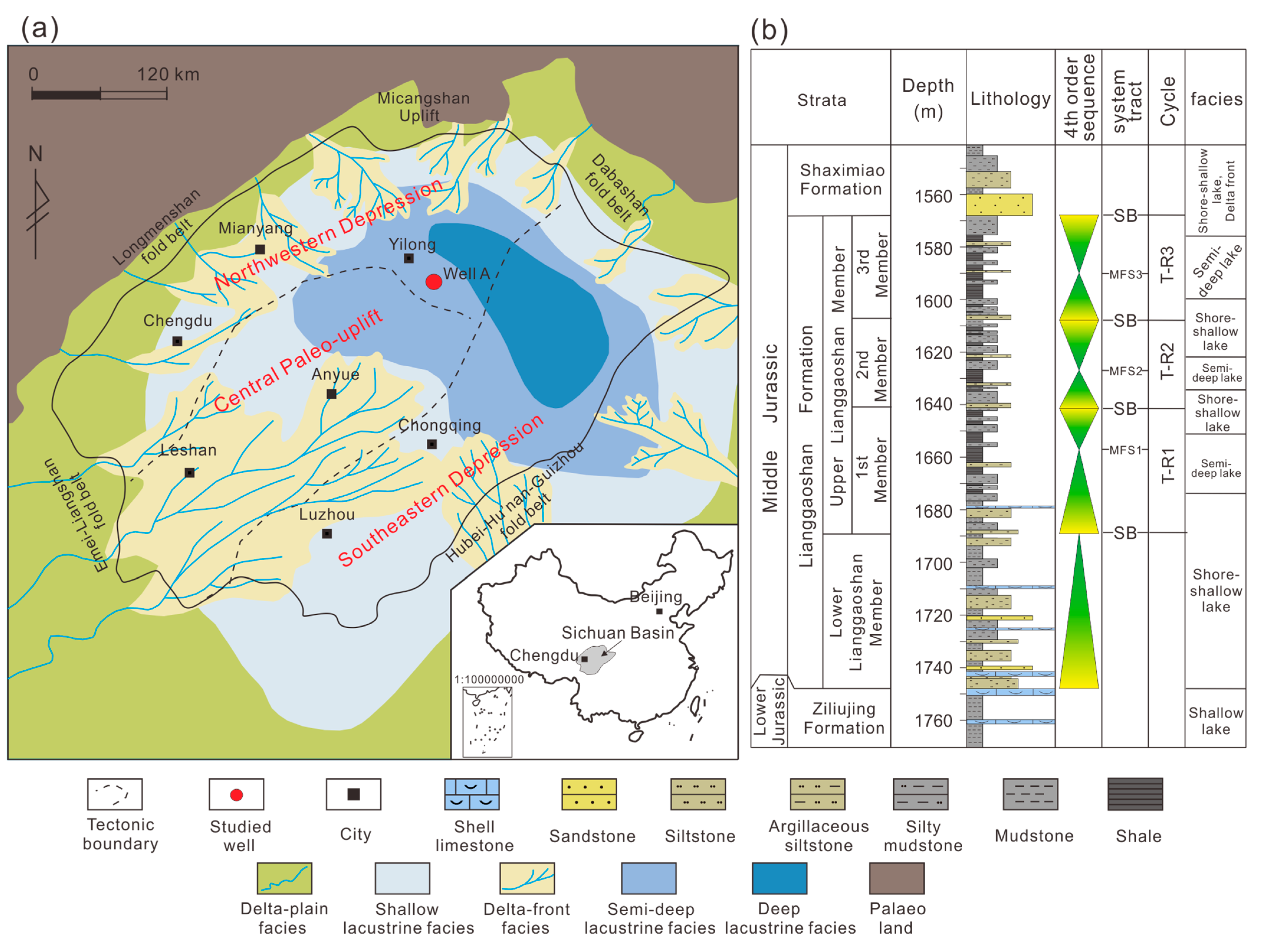

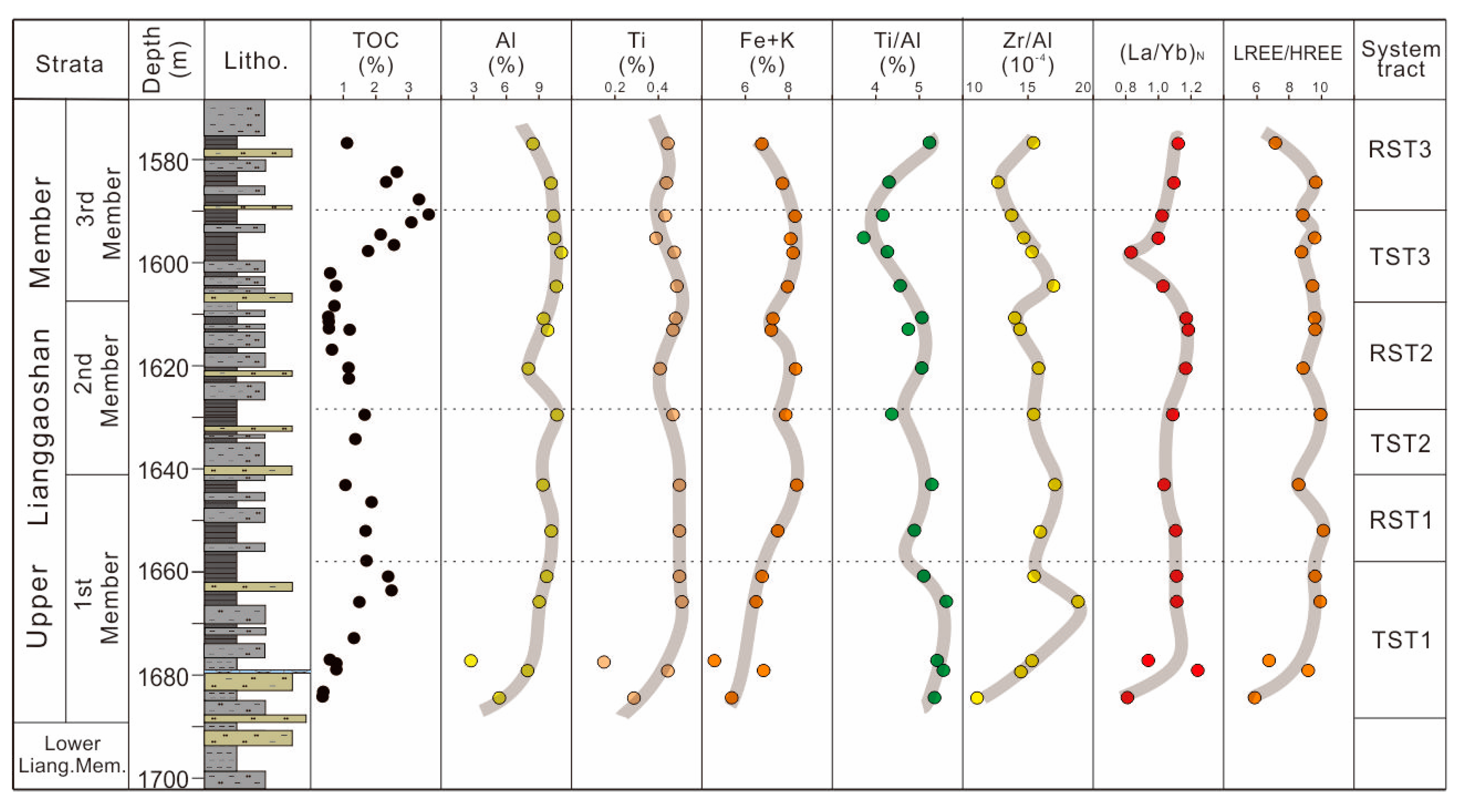
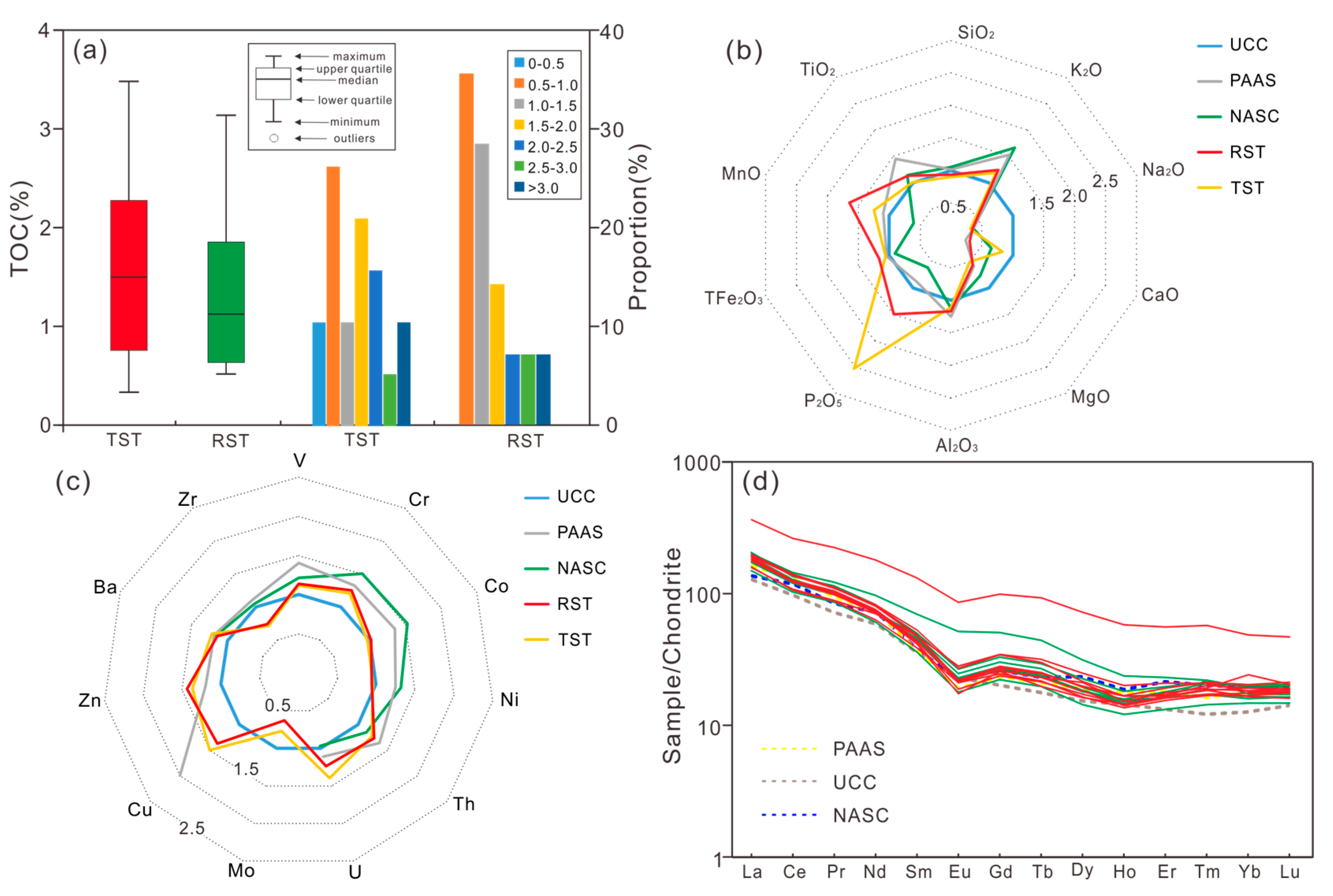
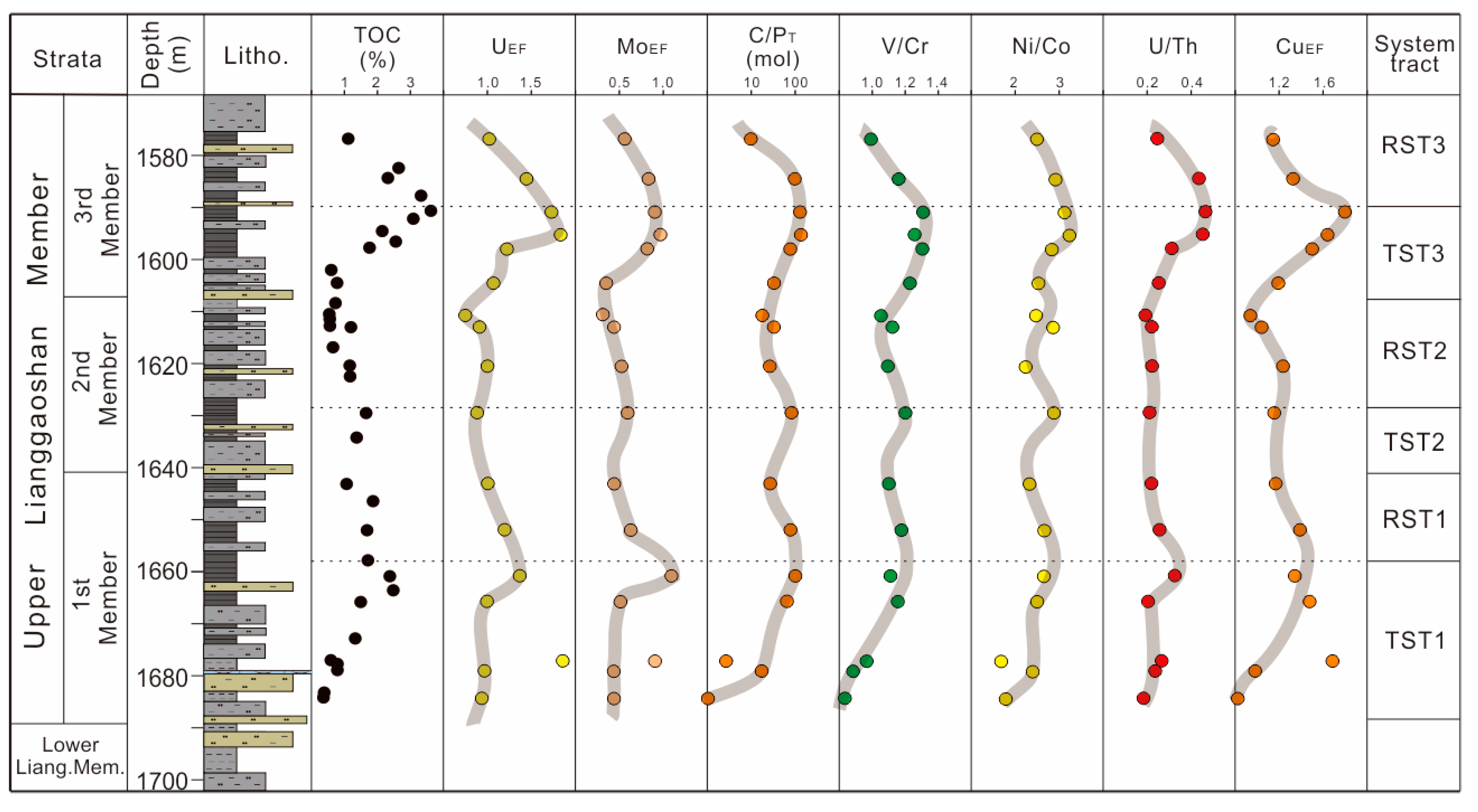
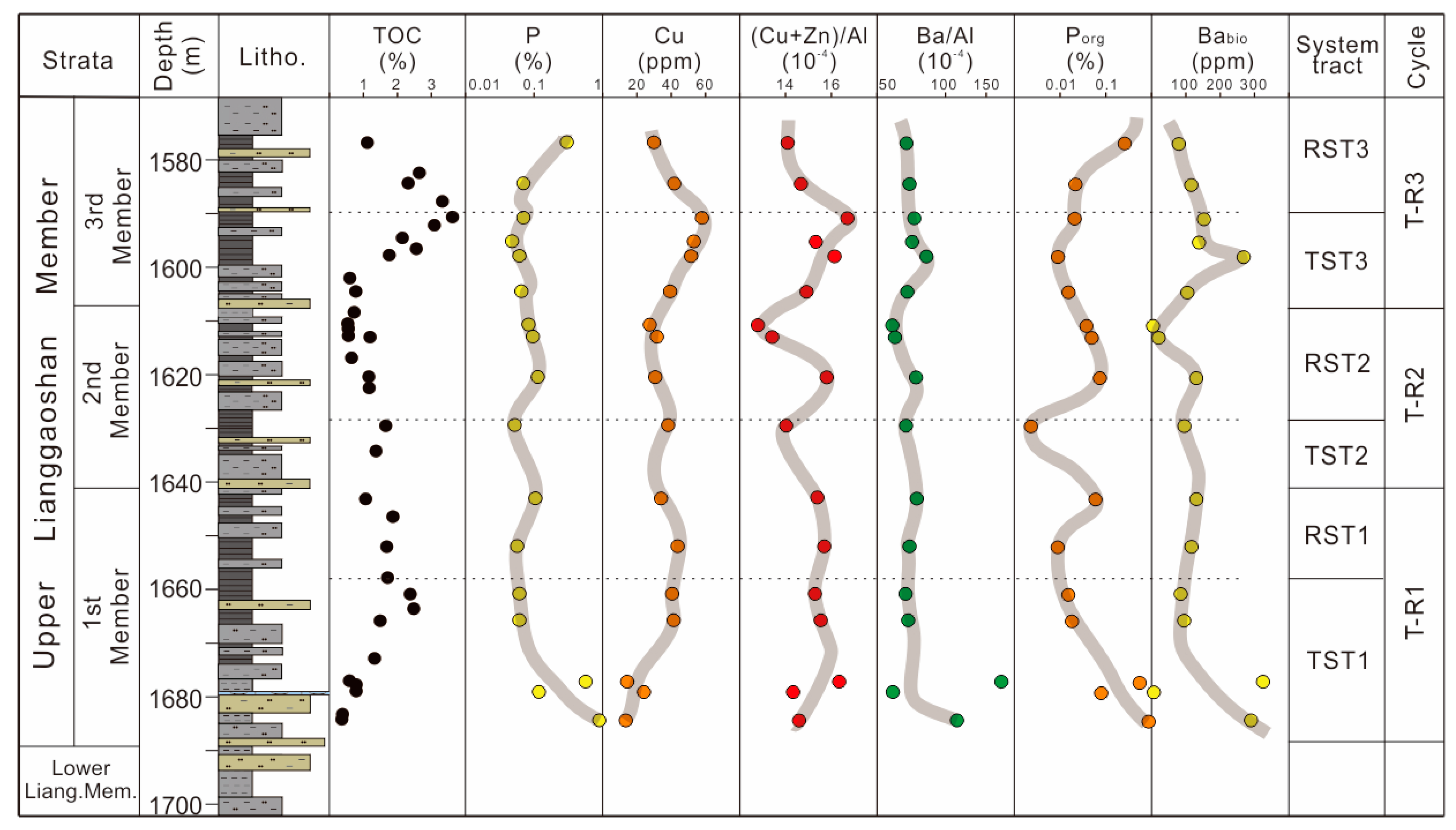
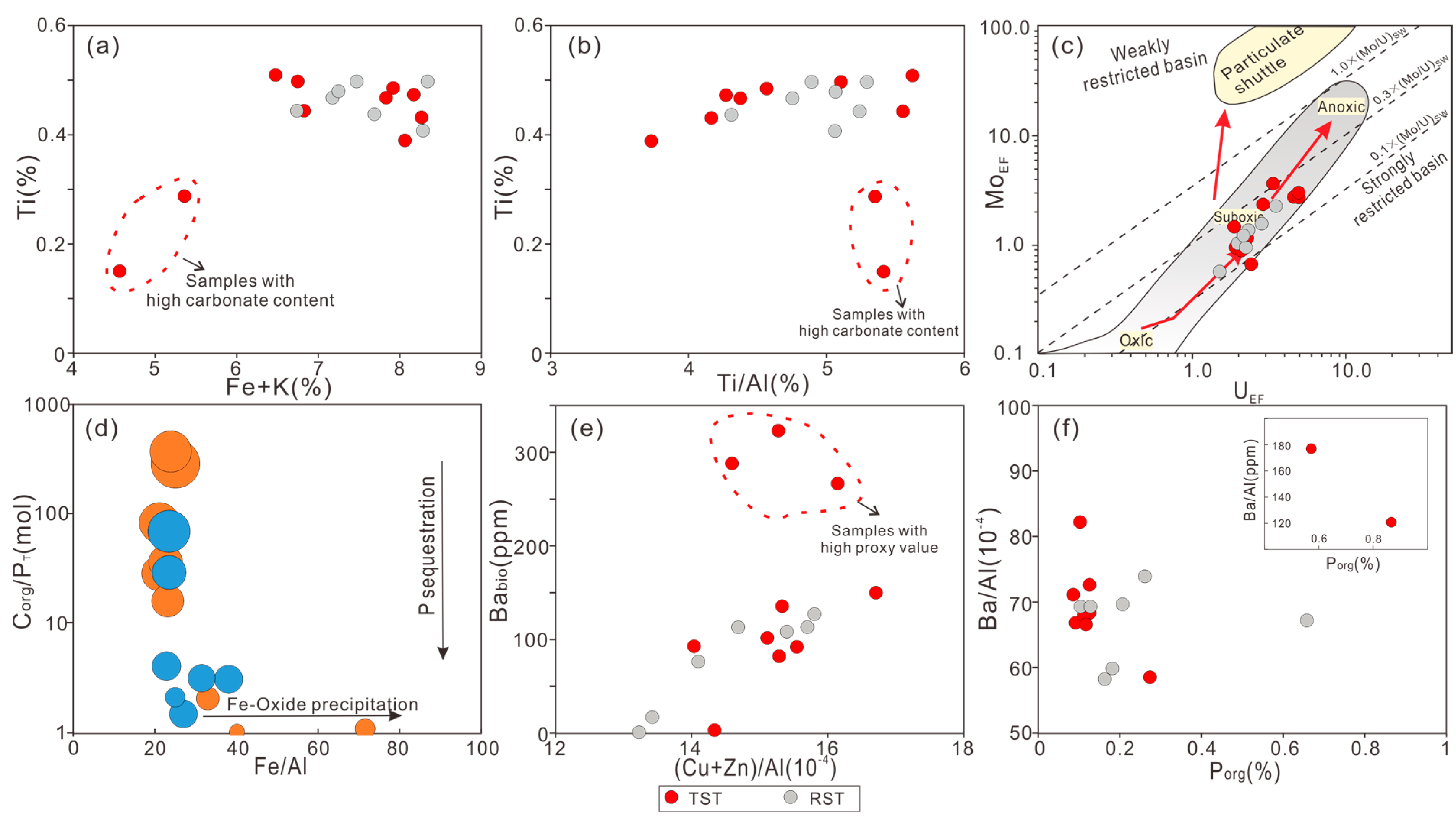
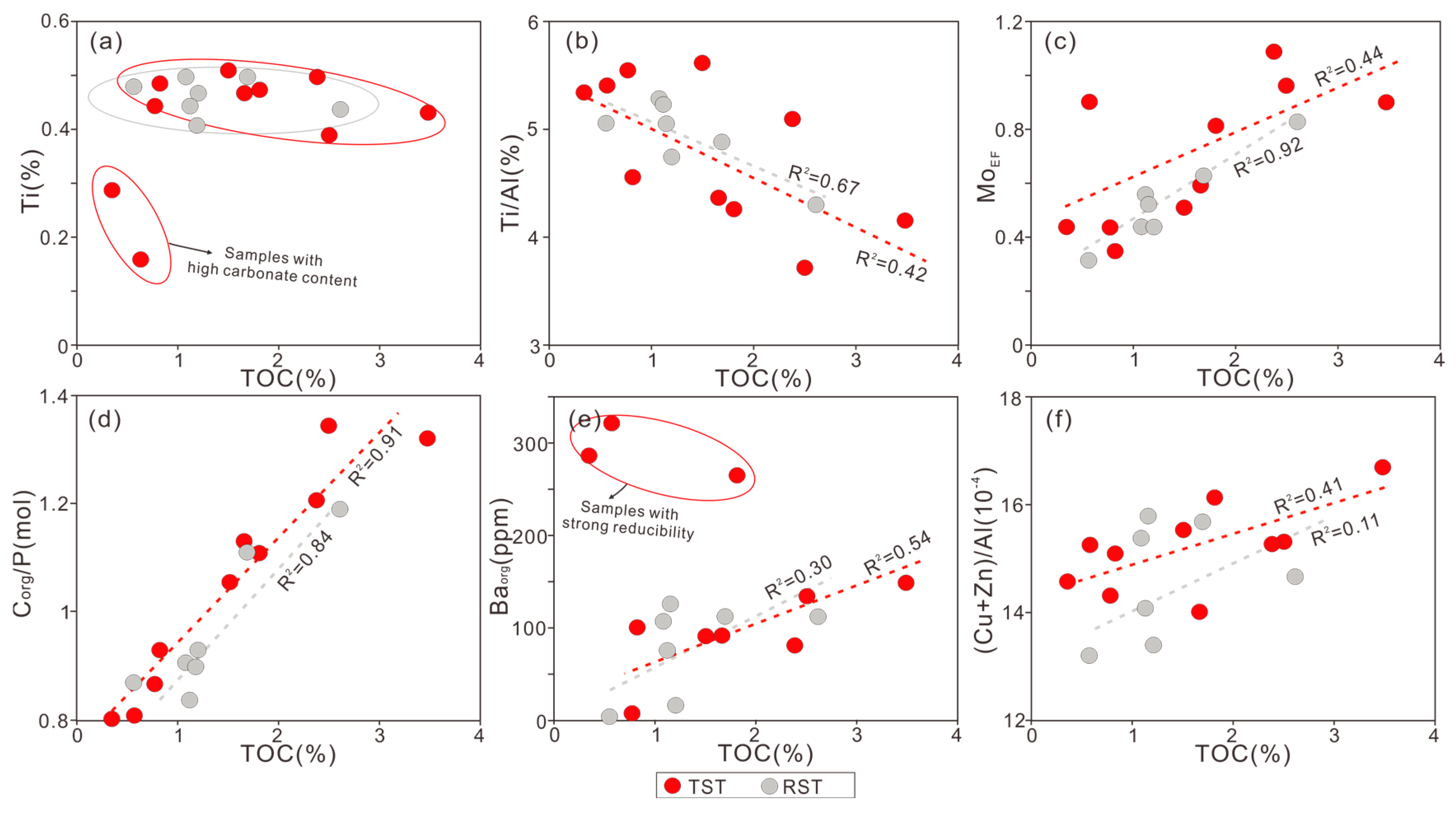


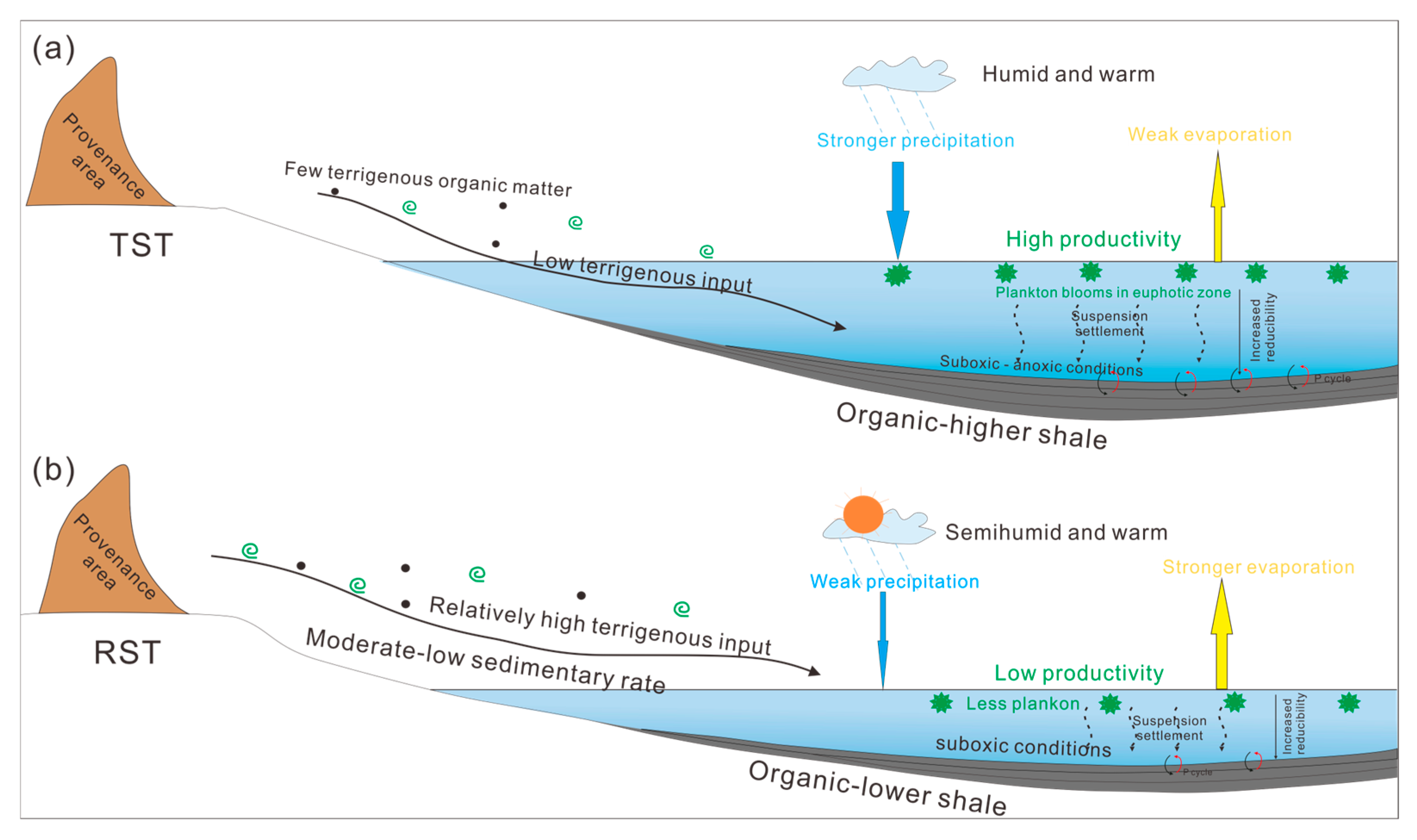
| System Tract | Values | TOC (%) | Quartz (%) | Plagioclase (%) | Siliceous (%) | Carbonate (%) | Pyrite (%) | Clay (%) | Illite (%) | Kaolinite (%) | Chlorite (%) |
|---|---|---|---|---|---|---|---|---|---|---|---|
| TST | Min | 0.36 | 29.70 | 5.90 | 35.60 | 0 | 0 | 37.20 | 32.00 | 7.00 | 18.00 |
| Max | 3.48 | 45.40 | 15.60 | 57.90 | 9.00 | 4.60 | 56.40 | 51.00 | 20.00 | 33.00 | |
| Average | 1.58 | 40.20 | 11.31 | 51.51 | 2.93 | 0.92 | 44.64 | 40.79 | 13.57 | 26.07 | |
| RST | Min | 0.53 | 17.50 | 5.70 | 24.50 | 0 | 0 | 13.30 | 25.00 | 8.00 | 21.00 |
| Max | 3.14 | 49.40 | 17.80 | 66.20 | 62.20 | 5.40 | 57.20 | 50.00 | 28.00 | 38.00 | |
| Average | 1.37 | 40.72 | 10.60 | 51.32 | 5.28 | 1.08 | 42.38 | 39.79 | 15.68 | 28.00 |
Disclaimer/Publisher’s Note: The statements, opinions and data contained in all publications are solely those of the individual author(s) and contributor(s) and not of MDPI and/or the editor(s). MDPI and/or the editor(s) disclaim responsibility for any injury to people or property resulting from any ideas, methods, instructions or products referred to in the content. |
© 2025 by the authors. Licensee MDPI, Basel, Switzerland. This article is an open access article distributed under the terms and conditions of the Creative Commons Attribution (CC BY) license (https://creativecommons.org/licenses/by/4.0/).
Share and Cite
Huang, D.; Qi, M.; Deng, X.; Huang, Y.; Wang, H.; Li, X. Organic Matter Accumulation Model of Jurassic Lianggaoshan Shale Under Lake-Level Variations in Sichuan Basin: Insights from Environmental Conditions. Minerals 2025, 15, 159. https://doi.org/10.3390/min15020159
Huang D, Qi M, Deng X, Huang Y, Wang H, Li X. Organic Matter Accumulation Model of Jurassic Lianggaoshan Shale Under Lake-Level Variations in Sichuan Basin: Insights from Environmental Conditions. Minerals. 2025; 15(2):159. https://doi.org/10.3390/min15020159
Chicago/Turabian StyleHuang, Dong, Minghui Qi, Xiang Deng, Yi Huang, Haibo Wang, and Xiawei Li. 2025. "Organic Matter Accumulation Model of Jurassic Lianggaoshan Shale Under Lake-Level Variations in Sichuan Basin: Insights from Environmental Conditions" Minerals 15, no. 2: 159. https://doi.org/10.3390/min15020159
APA StyleHuang, D., Qi, M., Deng, X., Huang, Y., Wang, H., & Li, X. (2025). Organic Matter Accumulation Model of Jurassic Lianggaoshan Shale Under Lake-Level Variations in Sichuan Basin: Insights from Environmental Conditions. Minerals, 15(2), 159. https://doi.org/10.3390/min15020159





